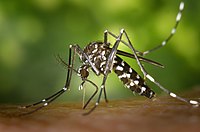
Photo from wikipedia
Background: In Switzerland, Aedes albopictus is well established in Ticino, south of the Alps, where surveillance and control are implemented. The mosquito has also been observed in Swiss cities north… Click to show full abstract
Background: In Switzerland, Aedes albopictus is well established in Ticino, south of the Alps, where surveillance and control are implemented. The mosquito has also been observed in Swiss cities north of the Alps. Decision-making tools are urgently needed by the local authorities in order to optimize surveillance and control. Methods: A regularized logistic regression was used to link the long-term dataset of Ae. albopictus occurrence in Ticino with socioenvironmental predictors. The probability of establishment of Ae. albopictus was extrapolated to Switzerland and more finely to the cities of Basel and Zurich. Results: The model performed well, with an AUC of 0.86. Ten socio-environmental predictors were selected as informative, including the road-based distance in minutes of travel by car from the nearest cell established in the previous year. The risk maps showed high suitability for Ae. albopictus establishment in the Central Plateau, the area of Basel, and the lower Rhone Valley in the Canton of Valais. Conclusions: The areas identified as suitable for Ae. albopictus establishment are consistent with the actual current findings of tiger mosquito. Our approach provides a useful tool to prompt authorities’ intervention in the areas where there is higher risk of introduction and establishment of Ae. albopictus.
Journal Title: International Journal of Environmental Research and Public Health
Year Published: 2022
Link to full text (if available)
Share on Social Media: Sign Up to like & get
recommendations!